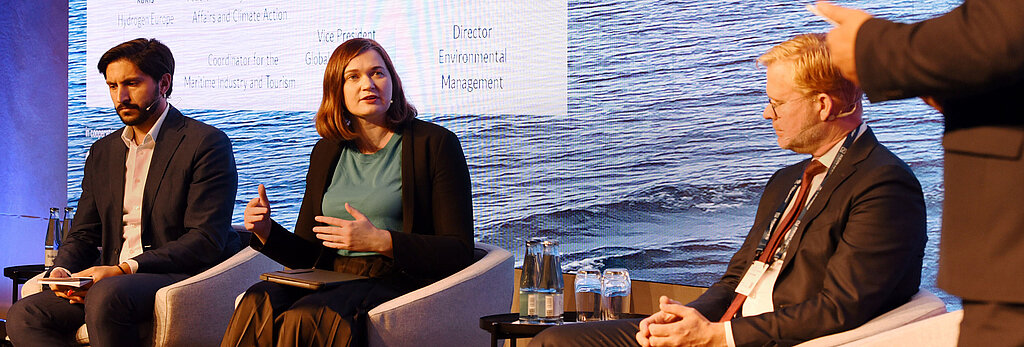Hamburg, 08-09-2022 – “’Driving The Maritime Transition’ is the leitmotif of this 30th edition of SMM. In the present environment, this is much more than a nice-sounding claim: It is plainly THE big challenge confronting the entire industry," said Claus-Ulrich Selbach, Business Unit Director Maritime and Technology Fairs at Hamburg Messe und Congress, in his welcoming address opening the gmec on the second day of the trade fair. There can be no doubt that the transformation of the maritime sector, in particular the switch from fossil to carbon-neutral propulsion technologies, must be implemented quickly, Selbach continued.
An assessment shared by the German Federal Maritime Coordinator, Claudia Müller who emphasised in her keynote that the shipping sector could, and should, be more ambitious. Shipowners have called the industry to action: “We are now all clear on the same target: to decarbonise as quickly as possible.” High energy costs, the unavailability of alternative fuels, and the need to convert the fleet in service to make it sustainable are huge challenges that must be tackled. This requires strict regulation, especially at the international level, said Müller, calling upon IMO to take action.
Words Kitack Lim, Secretary General of the International Maritime Organization, could sympathise with. Nevertheless, he asked to consider the difficult situation IMO was in: “We have 175 member states. Together we are working hard to revise our strategy, but we need to find a compromise so that every single member is on board," said Lim.
Hydrogen and the shipping energy mix
Craig Eason, Editorial Director of the online portal "Fathom World", moderated all five panel discussions at gmec. The event was sponsored by the American Bureau of Shipping (ABS). Georgios Plevrakis, Vice President of Global Sustainability at the US-based classification society, was on the first discussion panel which addressed hydrogen applications in the shipping industry. ABS is taking a very close look at the risks associated with this technology, he said: "Our industry does not have a 'lingua franca'. For us as a classification society, safety is not negotiable – it takes time. But we made major progress within one year and are advancing faster than expected." Plevrakis stressed the importance of establishing a global infrastructure, saying that it doesn't help if a ship bunkers hydrogen in Europe but is unable to refuel in Africa: "We have to look at the whole world,” he insisted.
Whether aviation, ocean shipping or road transport, around the world a wide diversity of industries will be competing for e-fuels. In response, Claudia Müller said, renewable energy production infrastructure must be built up faster while ensuring a level playing field, especially for developing countries. "We must treat them as partners, not merely as suppliers," she cautioned. “For shipping and beyond, the question we have to ask ourselves is this: Which energy source is best-suited and most efficient for specific applications?” For shorter distances, fuel cells and fully electric propulsion using batteries are feasible options, she said.
The Port of Rotterdam is considered a green pioneer. Over the next decade it intends to cut its CO2 emissions in half. Hydrogen plays a key role in this scheme: "By 2030 we will have an offshore wind power capacity of 7.4 GW available. The transmission lines will terminate at the Port of Rotterdam, where the electricity can be fed into the electricity grid or used for purposes such as hydrogen production by specialist companies," said Eric van der Schans, Director Environmental Management at the Port of Rotterdam. What concerns him is the ambiguity of the framework provided by the government: "Some parts of our port are quite close to residential areas. We must be able to depend on the safety of the new fuels, not only for the protection of residents but also to provide shipowners with a reliable bunkering infrastructure."
Navigating the zero-carbon transition
The second panel discussion began with a surprise announcement: Peter Wolf, Managing Director at CMA CGM, delivered the news that the French shipping company has created a 1.5 billion US dollar investment fund to finance the maritime energy transition over a five-year term. By comparison, a fund proposed by the International Chamber of Shipping (ICS) would have ultimately collected no more than 5 billion dollars over several years. "The maritime transition is a marathon. Our LNG ships were a first step. Many more steps will follow," said Wolf. Bio methanol is going to play a major role in this process, he added.
Elizabeth Munck af Rosenschöld, Sustainability Manager at IKEA, welcomed CMA CGM’s initiative. "The more we can do to accelerate the transition, the better," she said. "For our customers, the topic of sustainability is getting more and more important. This is why we have set ourselves the goal of becoming carbon-neutral by 2030. This includes transport," said Munck af Rosenschöld. While this is a challenge, she continued, "climate change will not wait." The Swedish furniture giant has a lot of influence in the industry, which the company wants to use to drive decarbonisation, she said.
The cruise industry is feeling increasing public pressure: "This is despite the fact that our industry has committed to becoming carbon-neutral by 2050 – sooner than the IMO target," emphasised Helge Grammerstorf, National Director of the Cruise Lines International Association (CLIA) Germany. People shouldn't forget that many cruise companies have made major contributions to technical innovations, he argued. "In 2018 AIDAnova was the world's first cruise ship with LNG propulsion. This was pioneering work." Now it was time to solve the hen-and-egg problem in terms of infrastructure and fuel. Global regulation would help, said Grammerstorf.
To Torgeir Sterri, Regional Manager West Europe at DNV, it is clear that there will be no "one-fuel-fits-all" solution. “Cooperation is the fuel of the future”, said Sterri. Pilot projects should be initiated to investigate various fuel options. Classification companies play a key role in this, he added: "When governments fail to create a binding legal framework, we must develop requirements to limit the risk of accidents; fuel safety is key." Sterri alluded to an incident in Norway in 2019 where a hydrogen fuel station exploded. "The subsequent discussions meant a five year setback for hydrogen development. We have to avoid these kinds of incidents by providing clear rules."
Nurturing green shipping innovation
Trust and transparency: The secret formula to drive innovations effectively, said David Connolly, Chief Technologist at Silverstream Technologies, during the third gmec panel discussion. But a pinch of money is necessary too, he said. Silverstream have developed an air lubrication system that reduces friction between ship and water, saving fuel. The British company is supported by private investors. It is important for all project partners to have skin in the game, Connolly said. Investors should never forget that failures are part of the game, and investments must be given a chance to unfold their potential, he said.
Chakib Abi Saab, Chief Technology and Innovation Officer at Lloyd‘s Register, provided some input from the class perspective: "We have to be honest: Investors want to make money. We have to find a way to make the energy transition financially attractive." A major portion of the maritime industry simply doesn't have the money to “green" their ships, he pointed out. The industry needs standardisation, he said, and LR are working hard to provide it.
Octavi Sadó Garriga applauded the industry's pioneers and first movers: "They give us climate leadership. After all, it is not just about saving fuel but also about learning processes. Will anything change for the crew? What is the best approach to system installation?" A ship design manager, Garriga works at the Mærsk Mc-Kinney Møller Center for Zero Carbon Shipping, a non-profit organisation established to drive the energy transition. The initiative was founded by major industry players, including ABS, A.P. Møller-Mærsk, Cargill, MAN Energy Solutions, Mitsubishi Heavy Industries, NYK Line and Siemens Energy.
Wind propulsion – the time is now
Once upon a time ships were propelled by sails. Today's maritime sector must take another hard look at this technology, said Cristina Aleixendri, Co-Founder of Bound4Blue, in the fourth panel discussion. "The industry is overly focused on green fuels. But there are other, sustainable propulsion solutions. Wind as an energy source is free – why shouldn't we take advantage of it?" asked Aleixendri. The automated wind sails manufactured by her Spanish start-up company can help ships save significant amounts of fuel, she pointed out.
Some rather practical insights were given to the audience by Johann Boomsma, co-owner of Boomsma Shipping. His company has installed two sails on board the general cargo vessel MV Frisian Sea, reducing fuel consumption by 5 per cent.
A total of 21 ships travelling the world's oceans are currently equipped with sails. "By the end of this year there will be 25 – this is important for our database performance," said Gavin Allwright, Secretary-General of the International Windship Association (IWSA). "Our ships use many different types of wind-assisted propulsion. This lets shipowners see that the technology really does make a difference." Many don't know much about wind-assisted propulsion, he deplored. "It is not a thrusting force but a suction force,” Allwright explained. Professor Dr Orestis Schinas from the consultancy HHX.blue agreed that this is the right approach: "For shipowners, the magic word is enhanced efficiency. This is how you convince them to retrofit." He added that owners willing to retrofit approach him frequently asking for concrete performance figures.
The NGO debate – is shipping doing enough to decarbonise?
"If we knew how we could accomplish this by tomorrow, we would do it," promised Lars Robert Pedersen, Vice Secretary-General of BIMCO. On the fifth and last discussion panel an NGO spokesperson confronted leaders from the maritime industry. For the first time the general public was admitted to an SMM conference event. Daniel Chatterjee, Director Technology Management & Regulatory Affairs at Rolls Royce, expressed his conviction that suppliers were not to be blamed because the technology was mature and readily available. "The maritime industry has switched from steam to oil, and the next transition will lead from oil to something else," said Chatterjee. The key question was which fuel will ultimately prevail. "We believe that methanol will be the new fuel. We must drive the development, and governments must ensure a level competitive playing field."
As for the kiss-me Aida fleet, said Hansjörg Kunze, VP Communication at AIDA Cruises, the programme is on schedule: For example, AIDAprima was recently retrofitted with a 10-megawatt battery, in his words the largest battery storage system deployed in the passenger shipping segment to date. "We want to deliver answers. We want to show what we are doing."
Sönke Diesener, Transport Policy Expert at the German Environmental NGO NABU, noted that the cruise industry cannot hide its "dirty work", no matter how hard it tries: "We can see it in every sustainability ranking." Nevertheless, he did give the segment some credit, saying: "A lot of media attention focuses on the cruise segment, but this is only part of our discussion. We are talking about the entire shipping industry and the need to decarbonise." He could tell, he said, that things have been changing in the sector: "We are moving in the same direction – some faster, some more slowly." But the shipping industry, generally rather slow to act, needs to pick up speed, he stressed. Referring to the previous panel discussion, Diesener asked: "If we are able to reduce emissions by installing sails on ships today, why isn't everybody doing it?"
There can be no doubt: The shipping industry is headed for decarbonisation but could accelerate its pace. There are enough good ideas around that would enable it to achieve its goals sooner, as the environmental conference and many exhibitors at the trade fair have demonstrated. Reason enough to look forward to the next gmec in two years and hear about the progress made in the meantime.


